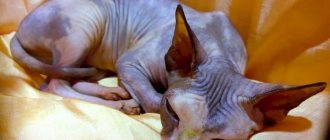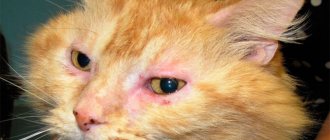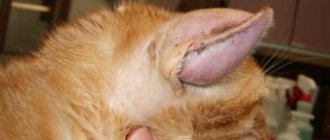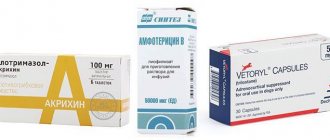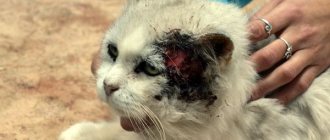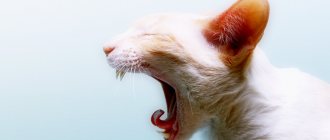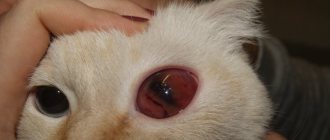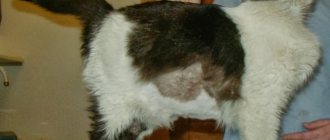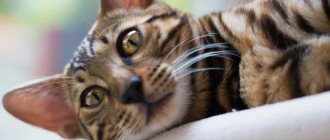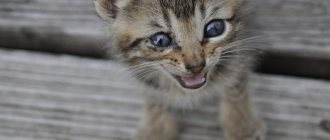Domestic cats often experience inflammation of the paraanal glands. However, many owners do not even know that their pet has them and what functions these glands perform. So that you can help your cat in a timely manner and prevent consequences dangerous to its health, see the most useful information about the signs and causes of inflammation of the paraanal glands.
Read in this article:
What are paraanal glands? Common causes of inflammation Signs of inflammation and abscess Treatment: main stages and methods
- Cleaning
- Washing
- Removal
Recovery after treatment Prevention of inflammation of the paraanal glands
What are paraanal glands and where are they located?
The anal glands in cats are small ball-shaped sacs located next to the anus on the inside. They perform an exocrine function, that is, they secrete a thick, sharp-smelling white or cream-colored secretion. Thanks to it, animals recognize each other by smell, attract the opposite sex and mark their territory. The secretion also participates in metabolic processes, facilitating the passage of feces.
Removal of paraanal glands in cats
If there is a recurrent process of inflammation of the glands, the animal is recommended to have a planned operation associated with their removal.
Surgical resection of the sacs containing paraanal secretions is performed, after which sutures are applied.
If necessary, the cat undergoes plastic surgery of the perianal area. After such an operation, the animal needs careful care and long-term rehabilitation.
Why do problems occur with the glands?
The natural outflow of secretions occurs due to muscle contractions during bowel movements or the application of territorial marks. If the secretion is disrupted, then liquid begins to accumulate inside. Stagnation is accompanied by severe itching and inflammation.
The main causes of inflammation of the paraanal glands in cats include:
- too narrow excretory canals inherited by the animal from birth;
- gastrointestinal pathologies;
- prolonged diarrhea or constipation caused by too much or too little fiber in the diet, respectively;
- anal injuries;
- anal sphincter insufficiency;
- infection with bacteria or helminths;
- obesity, metabolic disorders and physical inactivity;
- low immunity.
The risk group includes pets that do not go outside. Due to low physical activity and lack of need to mark territory, these cats experience blockage of the paraanal glands.
Prevention of inflammation
To prevent inflammation of the paraanal glands, cat owners must follow the following recommendations:
- Provide your pet with an active lifestyle using various toys or exercise equipment.
- If the anal glands become blocked too often, consult your veterinarian about their removal.
- Do not feed your cat bones or other foods that can injure the intestines or anus.
- Carefully monitor your pet's weight to prevent the development of obesity.
- Diversify your cat's diet. It is necessary to buy only high-quality ready-made food, do not give your pet only dry food, and with a natural diet you should properly balance proteins, fats, carbohydrates and fiber.
- Make sure your pet always has access to clean drinking water.
- Take your cat regularly to the veterinary clinic for preventive examinations.
- When the first signs of inflammation appear, take your pet to a doctor.
- Inspect the anal area monthly. This must be done in order to notice any deviations in time. It is especially important to follow this recommendation for owners of pregnant cats and neutered cats.
- Strengthen your pet's immunity with vitamins.
- Deworm your cat every six months.
- Monitor the hygiene of the area around the pet’s anus (this is especially true for owners of long-haired cats). It is recommended to carefully treat the anus and the area around it once every 2-3 months with a cotton pad soaked in an antiseptic solution.
- A kitten with inflamed anal glands should be taken to a veterinarian immediately. Children suffer from this unpleasant disease extremely rarely. The most common causes of inflammation of the ducts in kittens are frequent constipation due to poor diet or helminthic infestation. In addition, this problem can occur in premature or weakened animals.
Important! Owners of kittens should also remember that babies are prohibited from mechanical cleaning, using rectal suppositories, and washing the glands on their own.
Inflammation of the paraanal glands is one of the most unpleasant pathologies in cats. Unfortunately, such a seemingly insignificant problem can lead to the most severe consequences, including the death of the animal.
That is why it is important for cat owners to follow measures to prevent inflammation of the paraanal glands, and if pathology occurs, immediately seek help from a specialist.
Symptoms of the inflammatory process
When the excretory channels are blocked, the concentration and color of the exiting secretion changes. Gradually it becomes thicker and darker (even black). Curdled inclusions appear in it.
Due to the accumulated fluid, the glands increase in size. The resulting compactions can be detected by palpation. The act of defecation is accompanied by pain, so the animal behaves restlessly and constantly licks the anal area. In addition to the pain syndrome, severe itching occurs, which the pet tries to eliminate by riding on its butt. This symptom is similar to helminthic infestation.
Frequent licking worsens the condition of the coat - it becomes dull and falls out. Dandruff and increased fat content appear. Not only the anal area is affected, but also adjacent parts: the base of the tail, the sacrum, the inner side of the hind legs.
The resulting disturbances lead to a deterioration in appetite and general well-being. If a secondary infection occurs, the temperature may rise. The anus becomes swollen and looks dirty. An unpleasant odor appears that persists even after bathing. The cat constantly covers the anus with its tail, preventing palpation. Lameness may develop.
If you notice any of the above symptoms, you should be examined by a veterinarian. Timely diagnosis will prevent the development of complications.
Anal glands in cats: symptoms of inflammation
Often, pets lose their natural instincts, which leads to disruption of the emptying of their secretions and the appearance of stagnation.
In this case, the domestic cat develops painful bowel movements and severe pain in the perineal area, which prevents the animal from moving normally.
The cat loses its appetite and its body temperature rises. If the inflammation is prolonged, an abscess may occur, which can only be treated surgically (opening).
When inflammation of the glands occurs, the animal behaves as follows:
- constantly licks the anus;
- “travels across the floor” in order to eliminate stagnant secretions;
- presses tail;
- begins to emit an unpleasant odor;
- the glands in the anal area swell;
- When pressure is applied to the glands, a brown secretion with an unpleasant odor appears.
When a problem can be solved on your own
You can clean up accumulated secretions on your own, but only after examination at a veterinary clinic. Diagnostics is necessary to exclude pathologies with similar symptoms: helminthiases, allergies, mental disorders.
Mechanical cleaning – what is it?
Mechanical cleaning is a rather unpleasant, but very effective procedure that involves manually removing accumulated secretions. It is part of the complex treatment of inflammation of the paraanal glands in cats and is its mandatory step. The remaining stages, including rinsing and taking antibiotics, are prescribed on an individual basis.
Cleaning at home
The ducts are cleaned in two ways: internal and external. The first one is not performed at home, since without proper preparation it can lead to injury to the anus or rectum.
To carry out external mechanical cleaning you must:
- Make sure you have an assistant. The procedure is unpleasant not only for the owner, but also for the animal, so it will have to be constantly restrained. For safety, secure the cat with a towel.
- Prepare latex gloves and old unnecessary clothing. The extracted secretion smells bad. If you are not careful, it can end up not only on you, but also on furniture. It is safer to carry out the procedure in the bathroom.
- Gently squeeze the anus area, clasping it on both sides with your fingers. At this moment, hold the napkin where the stagnant secretion will flow. Focus on the condition of the animal. Don't press too hard if you see it's causing him a lot of pain.
- Disinfect the anus with Chlorhexidine after the remainder of the discharge is released.
If the above manipulations do not bring any effect, consult a doctor. Thickened secretions can only be cleaned internally. Also, in case of severe pain, novocaine blockade is recommended.
It is best to discuss the frequency of preventative cleaning with your veterinarian. The rate of blockage varies from person to person. The procedure can be carried out every six months or once a month, and sometimes there is no need for repeated cleansing at all.
Causes of abscess in cats
As we said earlier, the reasons for the development of an abscess are:
- damage;
- infection.
Infected with this pathology can be:
- epithelium;
- paraanal glands;
- oral cavity.
Most often, a cat’s abscess is a skin abscess, that is, a combat abscess, which developed as a result of receiving a bite in a fight with an enemy. As for harmful bacteria, which become infectious agents in each of the described cases, the following are most often found in pus:
- streptococcus;
- staphylococcus, etc.
It is during the reproduction of harmful organisms included in the class of pyogenic that a liquid substance is formed in the wound
However, it is not always necessary to damage the skin for the birth of an abscess. The infection will thrive in those tissues of the cat's body that have cavities, for example, in the gums surrounding the animal's teeth. Such an abscess forms when an infection enters your pet’s body and he is unable to fight it off on his own.
Treatment by a veterinarian
It is better to entrust the first cleaning to a veterinarian. The owners are allowed to be present at the procedure, which helps to understand its nuances in practice. You will also have to seek help if purulent discharge or fever appears. Both symptoms are fraught with complications, so any manipulation at home is excluded.
After passing the tests, the pet is given an accurate diagnosis and prescribed treatment. Depending on the stage of the disease, rinsing, medications or surgery are prescribed.
Washing
Washing is carried out in advanced cases when the animal has developed an abscess or a fistula. The procedure involves injecting an antiseptic solution based on Miramistin, potassium permanganate or Chlorhexidine directly into the affected organ using a syringe without a needle. This helps reduce the thickness of the secretion and facilitates mechanical cleaning. After washing is completed, antibacterial ointment is placed inside the anus, and a collar is put on the cat to prevent licking the treated area.
Use of medications
The inflammatory process is relieved with syntomycin ointment or Levomekol applied to the anal area. Both drugs have not only anti-inflammatory, but also antimicrobial effects. On average, the course of treatment with ointment is 10 days. To prevent licking, a protective collar is put on the cat.
In addition to ointments, rectal suppositories are used, but strictly as prescribed by a doctor. If the process is started, they can harm the animal. Methyluracil is used to accelerate the regeneration of damaged tissues. If a pet is diagnosed with eczema or bacteria, it is treated with intramuscular injections of Dexafort, Tetracycline or Amoxicillin.
When may surgery be needed?
With frequent relapses, when mechanical cleaning does not bring the desired effect, the mustachioed patient is prescribed surgery. Also, removal of the paraanal glands in cats is carried out for abscesses and other advanced complications. In this case, the abscess is excised along with the inflamed organ and its ducts.
Despite the use of general anesthesia, the operation is a mild one. Rehabilitation is quick and rarely accompanied by complications. The absence of an organ does not have a negative impact on the condition and vital functions of the animal, but only eliminates further relapses.
The only possible complication is constipation. If it occurs soon after surgery, you should consult a doctor, since stagnation of feces can lead to suture divergence.
Treatment: main stages and methods
Treatment of inflammation or abscess of the paraanal glands should only be carried out by an experienced veterinarian in Moscow. We strongly do not recommend trying to help your pet at home. This will only worsen an already difficult situation.
The first step in treating inflammation is diagnosing the animal's condition. The veterinarian examines the affected area, interviews the owner (about the severity of symptoms, the degree of their manifestation, etc.), after which he assesses the cat’s condition and prescribes treatment.
Cleaning
If you consult a doctor in a timely manner (at the first stage of the inflammatory process), then treatment will be limited to cleaning the paraanal glands. This procedure does not require special conditions, so it can be performed in the clinic or at home, but only by a professional veterinarian.
Before cleansing the glands of accumulated secretion and secretion, it is necessary to palpate them. This will allow you to determine the consistency of the contents and select a cleaning method. If the secretion is liquid, then the external method is used, if it is dense, the method of rectal sanitation is used.
After cleaning is completed, the affected area is thoroughly treated using an antiseptic solution. To prevent further inflammation (preventive measure), an anti-inflammatory suppository is inserted inside.
Washing
Unlike external cleaning, washing the paraanal glands cannot be done at home. It is carried out only in a veterinary clinic, since it is prescribed in difficult situations (for example, when a fistula forms).
Before washing the abscess, the glands are cleared of accumulated secretions, then an injection is given with local anesthesia. Next, the specialist injects an antiseptic solution into the anus using a catheter (an alternative is a syringe without a needle).
Washing is carried out not once, but several times. This is necessary so that the liquid flowing back (antiseptic solution) becomes completely transparent. This condition indicates that there is no secretion or purulent discharge left.
After washing, the pet is given an anti-inflammatory suppository, and the damaged area is carefully treated with antiseptic ointment. If the cat's condition is of concern, the specialist will prescribe a course of antibiotics.
Removal
Unfortunately, washing does not always give a positive result. In particularly severe situations (for example, with a developed abscess), the veterinarian resorts to an extreme method of treatment - surgical removal of the paraanal glands.
The surgery is performed using general anesthesia. The surgeon makes two incisions in the area where the glands are located, and then removes them along with the ducts. Then he puts stitches and treats with an antiseptic solution.
After surgery, your cat will need home care. In order for it to fully recover, it is necessary to regularly treat the area with regenerating agents (solutions, ointments), give vitamins and antibiotics for 7-10 days.
Are there any complications?
Prolonged development of the inflammatory process is fraught with the development of abscess, sepsis and adenosarcoma (tumor). Stagnant fluid creates an environment favorable for bacteria, stimulating their proliferation. Pathogenic microorganisms spread through the rectum, infecting neighboring organs and systems through the blood. Such extensive intoxication can be fatal. Also, opening an abscess can affect the integrity of the glands.
In addition to possible blood poisoning and cancer, the pathology is dangerous due to possible chronicity. In this case, the animal experiences frequent relapses - they negatively affect the general condition and cause secondary diseases. Chronic inflammation is treated only surgically.
Cats anal glands
A cat's anal glands, or anal sacs, are located on either side of the anus. They would be at five and seven on the clock. Since they are a gland that secretes fluid, it is used for two main purposes:
- Lubrication of stool to facilitate bowel movements.
- Create a unique scent that cats use to identify and mark territory.
They can be found by pressing on the anus area, but they are usually not very noticeable. If any, it may be due to inflammation or another cause of swelling. Because they contain a unique scent, it is not uncommon to see other cats smelling this area as a means of greeting.
When a cat defecates, the feces pushes the glands and causes them to secrete fluid . However, there are other circumstances that can cause the anal sphincter to contract, in turn compressing the anal glands and emptying them. An example is fear, such as what a cat might experience when visiting a veterinary clinic. When this happens, you may see a clear liquid coming out of your cat's anus...
Gland problems in kittens
Inflammations occurring in kittens are very rare. In most cases, the owner is to blame for breaking the feeding rules. Also at risk are babies born prematurely or weakened by other diseases.
Due to the fragility of the child’s body, it is better to entrust treatment to a veterinarian. The introduction of rectal suppositories, lavage and mechanical cleaning are contraindicated for kittens. It is preferable to use anti-inflammatory ointments. The exact dosage and method of use should be obtained from your doctor.
Complications caused by an abscess
The development of an abscess, as we have already mentioned, has a direct impact not only on the occurrence of pain and the appearance of pus in the infected area, but also worsens the overall well-being of the pet. Among other things, this pathology is also capable of creating favorable conditions for the occurrence of other diseases and the progression of infection.
What complications can occur with an abscess in cats?
So, provided that you did not make a decision on timely treatment of the cat’s abscess or discovered the abscess too late, these consequences and complications can complicate the life of your pet, and yours along with it.
Thus, abscesses are characterized by pain. A constant feeling of pain seriously affects the animal’s psyche, causing:
- groundless aggression;
- nervous tension;
- sudden weight loss;
- attempts to tear objects;
- going to the toilet in a variety of places, for example, on the sofa or the owner’s bed.
Groundless aggression
Another dangerous complication can occur like this: the infection from the abscess will spread into the tissue and infect such important elements of the cat’s body as:
- ears;
- joints, etc.
This can also happen when the wound is located on the very surface of the skin, or is far from the ears
Cats infected with a combat abscess are most susceptible to such terrible diseases as feline AIDS, etc.
Infection from an oral abscess can spread to the brain. In this case, the animal will begin to behave inappropriately and, most likely, will die in agony.
As you can see, curing your pet quickly is your main task. Adopting a cat means not only having a furry friend that you can hug and pet, but also acquiring a huge responsibility towards him. This responsibility includes feeding a quality diet, constant attention, regular bathing and grooming, and timely and regular veterinary visits.
If you are not ready to spend time and money on maintaining and treating a cat, it is better not to adopt it in the first place.
You can also think that the larger the abscess, the more pus and blood will be released from it, which will stain the furniture, floors, and walls that the animal touches. Take pity on him and yourself and immediately run to the doctor.
Treatment of abscess (abscess, abscess) in cats
Of course, today many owners of cats with an abscess have turned to veterinarians, so today there are the most effective schemes for eliminating the desired pathology. Exactly how your pet will be treated will depend on what stage of development the disease is in when presented.
How are abscesses treated in cats?
First stage
In the early stages, treatment with the following drugs is used:
- penicillin antibiotics to eliminate harmful microorganisms;
- novocaine to eliminate pain;
- streptocides to fight infection.
All of the above drugs are taken orally, while external treatment is also practiced, namely:
- lightening with a Sollux infrared lamp to resolve inflammation and relieve pain;
- ultraviolet light to dry the wound;
- heating pad and warming compresses to eliminate pain.
All of the above procedures allow you to eliminate the abscess quickly and with minimal losses to the cat’s health.
Second stage (formed abscess)
Treatment of an abscess that has already formed is carried out through invasive intervention, since the main task of doctors at this stage is to remove the purulent substrate from the wound. For this:
- the animal's fur is shaved off at the site of the inflamed area and around it;
- the animal's skin is disinfected;
- the animal is put into a state of anesthesia;
- a long incision is made at the site of inflammation;
- the wound is opened and all accumulated pus is removed.
it is very important to leave the wound open and dry, because the pus that is not completely removed will then lead to the re-formation of an abscess.
A cat who has received this treatment is prescribed:
- washing the wound with antiseptics (not alcohol, otherwise the tissue will be burned);
- taking antibiotics.
Treatment of the wound
Fortunately, due to the ability of the animal body to recover very quickly, which we previously mentioned, after cleaning the wound, the animal recovers almost within a few days.
Third stage (advanced abscess)
Provided that for some reason you have started the disease, and the abscess has spread deeply and grown to a substantial size, doctors, just as in the second stage, will open the wound and clean it of pus. However, in this case, you will have to sew it up, not just like that, but leaving the latex tubes sewn in so that the cleaned cavity can be drained from the newly formed pus.
Drainage tube
Vishnevsky ointment will need to be applied to the stitched wound, and after some time the wound will be cleansed through sewn-in tubes by injecting antiseptic drugs into them.
It also happens that due to the presence of an abscess in an animal, a necrotic process has begun in the tissues located next to it. In this case, they will need to be removed and processed:
- hydrogen peroxide;
- potassium permanganate;
- hypertonic solution.
Then the location of the former abscess should be sprinkled with antiseptic powders, and drainage with a hypertonic solution should be installed.

